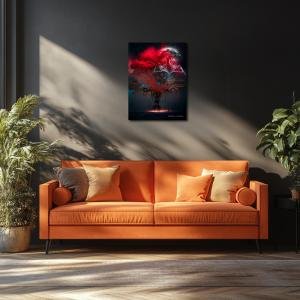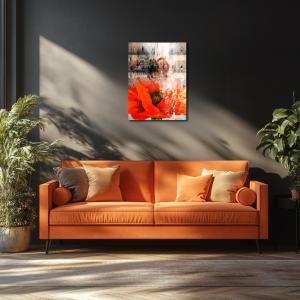Petal of Silence: White Rose Reimagined
Petal of Silence reinterprets Georgia O’Keeffe’s White Rose as an immersive floral dreamscape where femininity, form, and fragrance merge into one sacred breath. A translucent figure born from petals embodies the quiet power of identity, while soft whites, pale lavenders, and blushing peaches spiral across the canvas, evoking emotional nuance and sensual truth. The composition blends woman and rose into a single unfolding presence—delicate yet defiant, inviting the viewer into a space where silence is not absence but essence. In this sacred bloom, softness becomes strength and vulnerability becomes divine.
Please see Below for Details…
Hotline Order:
Mon - Fri: 07AM - 06PM
404-872-4663
Petal of Silence is a conceptual reconstruction of Georgia O’Keeffe’s White Rose , a floral meditation that transforms sensual stillness into transcendental grace. This reinterpretation does not merely echo O’Keeffe’s affinity for magnified florals—it dives into the secret soul of the bloom, opening it layer by layer until it becomes something more than a rose: it becomes woman, breath, and mystery. Through surreal composition and ethereal layering, the piece invites viewers into a world where flower and figure merge in a choreography of soft vulnerability and divine strength.
O’Keeffe once stated, “When you take a flower in your hand and really look at it, it’s your world for the moment.” This artwork magnifies that moment into a universe. The composition is engulfed in a bloomscape of white, ivory, and blush petals that spiral across the canvas like soft echoes of breath. In the center, subtly emerging from within the floral cosmos, is a translucent feminine figure, her face formed by roses, her body sculpted from light and petal curvature. She is the rose, and the rose is her—delicate yet defiant, layered and luminous, a soul in full bloom.
The white rose dominates the canvas, not with stark simplicity, but with a layered complexity. It is not a single petal, but many—each fold gently transitioning from ivory to pearl, from frost-touched alabaster to warm candlelit cream. These transitions are not accidental. They are whispers of O’Keeffe’s nuanced relationship with femininity—one not trapped in purity, but alive in emotional shading. The bloom’s inner shadows, painted in soft gray-violets and muted pewters, speak of hidden thoughts, unsaid words, and the silent spaces between self-perception and societal expectation.
Near the lower left, soft periwinkle and indigo hydrangeas mingle with pale blue forget-me-nots and snow-white daisies. These flowers act as subtle emotional contrasts to the central rose: the blues bring in calmness, mourning, and contemplation, while the daisies offer purity without pretense—a childlike softness beside the womanly bloom. These hues anchor the composition in emotional truth, suggesting that growth—whether of spirit or identity—emerges from quiet moments of reflection and natural grace.
In the upper right quadrant, peach-toned and muted mauve petals blend into translucent flesh tones, forming a dreamlike image of a reclining figure, head bowed slightly as if in prayer or introspection. Her limbs dissolve into petals and mist, emphasizing the theme of unity between form and essence. This figure is not passive. Her quietness is powerful, her gaze is internal, and her very posture suggests an unspoken reclamation of identity.
The background is kept light, nearly vanishing into a wash of cream and lavender mist. This lack of heavy backdrop allows the floral and human forms to float freely, unbound by space or gravity. The white is not blankness—it is invitation. It’s the silence before music, the page before poetry, the breath before confession. O’Keeffe’s original intention—to allow the viewer to truly see the flower—is honored here by letting the flower become a doorway, not a subject.
The emotional essence of this reinterpretation lies in how it invites the viewer to feel without forcing direction. The softness does not dull the power. The transparency does not imply weakness. On the contrary, the dissolution of boundaries between woman and flower suggests a form of transcendence—the woman as organic, eternal, and deeply sacred.
The palette is unified in tones of cream, white, lavender, soft peach, and dusty rose, woven through with occasional hints of deep blue and ghostly shadow. These color choices are deliberate, each tone holding symbolic weight. White represents clarity, mourning, and rebirth. Lavender and blush hues express intimacy and subtle sensuality. Blues and purples add undertones of solitude and spiritual weight, while the barely-there grays lend the image depth, like the quiet gravity behind every whisper.
In this reimagination, White Rose becomes not a flower seen from above, but a world entered from within. The viewer is no longer outside the bloom but folded into it—its pulse, its breath, its layered story. And through it, the viewer also becomes the bloom, shedding rigid boundaries and embracing a truth that O’Keeffe herself lived: that beauty does not demand permission, and quiet does not mean invisible.
Add your review
Your email address will not be published. Required fields are marked *
Please login to write review!
Looks like there are no reviews yet.








